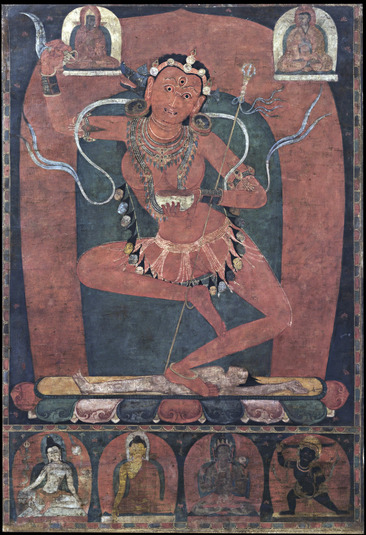
Item: Vajrayogini (Buddhist Deity) - Vajravarahi, Red
| Origin Location | Tibet |
|---|---|
| Date Range | 1000 - 1099 |
| Lineages | Kadam and Buddhist |
| Material | Ground Mineral Pigment on Cotton |
| Collection | Private |
Classification: Deity
Appearance: Semi-Peaceful
Gender: Female
Vajravarahi Vajrayogini, circa 1100, with two teachers above and four deities below.
At the top of the composition are two figures of teachers. On the left side, wearing a yellow hat, is very likely to be Atisha. The figure on the right is quite possibly Dromton.
[77] Vajravarahi (Bari Gyatsa): "Vajravarahi, with a body red in colour, one face and two hands. The right [hand] holds, in a manner held aloft, a vajra curved knife. The left holds to the heart a blood filled skullcup and carrying a katvanga [in the bend of] the elbow. Having three eyes and bared fangs. Having a crown of five dry human skulls and a necklace of fifty fresh. Adorned with a garland of flowers. Wearing a lower garment of tiger skin. Standing in a dancing manner with the left leg extended in a half [vajrasana] posture." (Konchog Lhundrub).
At the bottom left side is Simhanada Lokeshvara, white in colour, without ornaments. To the right side is Shakyamuni Buddha. On the bottom right side is Krodha Achala, wrathful in appearance, blue in colour, standing in an aggressive posture. To the left side is Chaturbhuja Lokeshvara with one face and four arms.
"... a lion with the head looking to the right. Above that is a moon disc ... the Lord of the World, Simhanada, with a body white in colour, having one face and two hands, three eyes, with the hair bound in a topknot. The right hand is extended above the knee in the refuge giving gesture and the left placed firmly on the seat behind the back. Having the appearance of an ascetic, seated in the lalitaraja posture. On the right side is a white snake coiled around an upright trident and on the left side, above a lotus stem is a skullcup filled with various fragrant flowers and adorned with a flaming sword." (From an edited version of the Bari Gyatsa by Ngorchen Konchog Lhundrub (1497-1557). GTKT, vol.12, folio 258. Jeff Watt, October 1984. Vancouver, Canada).
"Above a lion supported jewelled throne, multi-coloured lotus and vajra together with a moon disc...Muni Vajrasana with one face and two hands. The right is in the gesture of subduing and the left in the gesture of meditative equipoise. Seated in the vajrasana posture. Wearing saffron religious robes and adorned with the thirty-two major and eighty minor marks of perfection. Having the appearance of holiness." (Konchog Lhundrub).
"As the nature of all buddhas, Avalokiteshvara, in colour like stainless conch and crystal, very resplendent, smiling, peaceful and radiant. With four hands the first are folded at the heart, the lower hold a crystal mala and jewelled lotus, two beautiful feet seated in vajra posture, adorned with many attractive silks and jewels, beautified with dark blue hair in tufts [some] loose. On the crown of the head, the wisdom of all buddhas, is the Lord, source of all refuge gathered as one, in essence the Guru in the aspect of Amitabha, in the manner of the Lord of the Family, seated happily." (Ngorchen Konchog Lhundrub 1497-1557).
"...Arya Achala with a body blue-black in colour, one face and two arms. The right hand holds up to the sky a wisdom sword. The left [performs] a wrathful gesture together with a lasso. [Achala] has three eyes, red and round, orange hair bristling upwards. The limbs are adorned with snake ornaments and jewels, a tiger skin as a lower garment. Within a vast swirling mass of wisdom fire [he] stands with the right leg bent and the left straight atop Vinayakaraja [the king of hindrances]. Vajrasattva adorns the head." (Drub Tab Kun Tu, vol.13, Nartang Gyatsa, pp.861-862. TBRC W19221).
Jeff Watt 12-2018
Subject: Art & Tantric Symbolism
Painting Style: Indian (11th to 13th century)
Subject: Dakini (Popular Deities)
Buddhist Deity: Vajrayogini, Vajravarahi Main Page
Buddhist Deity: Vajrayogini, Varahi (Painting Masterworks)
Collection of WGA
Buddhist Deity: Vajrayogini (Early Paintings)
Buddhist Deity: Vajrayogini, Varahi (Sow Head on the Right Side of the Face)
Buddhist Deity: Vajrayogini, Vajravarahi Art History
Iconography: Popularity of Deities
Buddhist Deity: Vajravarahi (Best Examples, Painting)
Tradition: Kadam (Early Paintings)
Buddhist Deity: Vajrayogini, Vajravarahi (Iconographic Variations)
